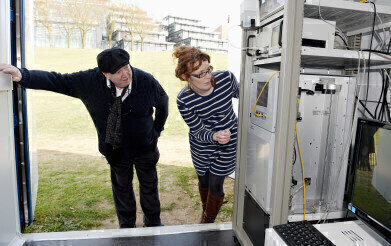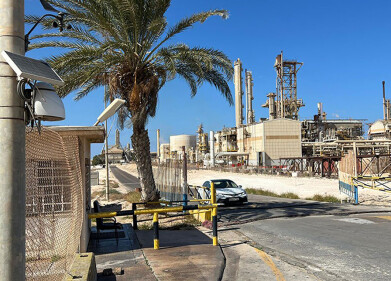-
 MEP Keith Taylor with Dr Kirsty Smallbone at the Air Quality Monitoring station at Falmer
MEP Keith Taylor with Dr Kirsty Smallbone at the Air Quality Monitoring station at Falmer
Air Quality Monitoring
Hidden Killers in the Air
Apr 03 2016
University of Brighton scientists are pushing the boundaries of research into air pollution which is responsible for more than 50,000 preventable deaths in the UK every year, according to Keith Taylor, Member of the European Parliament for the South East.
After visiting the university’s new £250,000 advanced air quality monitoring station at the university’s Falmer campus, he said: “The project here is researching ultra-fine particles which have not yet received much scientific study yet represent a real danger to human health.
“All over the UK local authorities are recognising the challenges air pollution represents and we have to use whatever we can to improve human health and save lives.”
The monitoring station, the first of its kind in the UK to detect harmful nano-sized particles and their gaseous precursors, opened in December. Mr Taylor, a member of the EU Environmental Health Committee, said he will be keeping a close watch on the research findings.
Plants can be the source of nano particles but it is the man-made particles such as those from traffic that can be mitigated, according to lead researcher Dr Kirsty Smallbone. She said a traffic-free city centre in Brighton or congestion charges could be considered but there was always a balance to be had between accessibility and cleaner air. A more affordable public transport system could also be considered.
Children and vulnerable adults are particularly at risk, she said, and air filtration systems for schools, hospitals and other public buildings are now being looked into.
The station was funded by the EU’s Interreg IVB NWE programme and the University of Brighton as part of the Joint Air Quality Initiative (JOAQUIN, www.cleanerairbetterhealth). It comprises part of a wider “next-generation” monitoring network spread across North West Europe.
The university’s Air Environment Research team will use the station to investigate a range of modern day air pollutants, including so called ultrafine particles, nanometer-sized material suspended in the air that is capable of penetrating deeply into the human body where it can cause a range of negative health effects.
Dr Smallbone and Dr Kevin Wyche, lead scientist, both from the College of Life, Health and Physical Sciences, welcomed the MEP’s visit and said communicating and raising awareness of the hidden dangers of air pollution was vital to seeking solutions.
They said: “Poor air quality is believed to result in around 50,000 deaths per year in the UK, according to Public Health England, and is thought to reduce people’s life expectancy by an average of nine months across the European Union.
“Additionally, the World Health Authority reported that outdoor air pollution kills more people worldwide than road traffic accidents, smoking and diabetes combined.
“Brighton is still exceeding air quality limits set by the government…and air pollution is suspected of causing 115 deaths per year in Brighton and Hove.
“In light of such dramatic statistics and estimates, it is crucial that we enhance our understanding of the relationships that exist between pollutants and health, and the station will provide a solid platform for us to do just this; it will provide unparalleled insight into the kinds of pollutants we breathe, their complex interactions and how they evolve.
“It will give us the unique ability to provide policy makers, scientists and the general public with the vital information required to help improve the quality of our air and protect our health.”
Digital Edition
AET 28.4 Oct/Nov 2024
November 2024
Gas Detection - Go from lagging to leading: why investment in gas detection makes sense Air Monitoring - Swirl and vortex meters will aid green hydrogen production - Beyond the Stack: Emi...
View all digital editions
Events
Jan 14 2025 Abu Dhabi, UAE
Jan 20 2025 San Diego, CA, USA
Carrefour des Gestions Locales de L'eau
Jan 22 2025 Rennes, France
Safety, Health & Wellbeing LIVE
Jan 22 2025 Manchester, UK
Jan 25 2025 San Diego, CA, USA


















